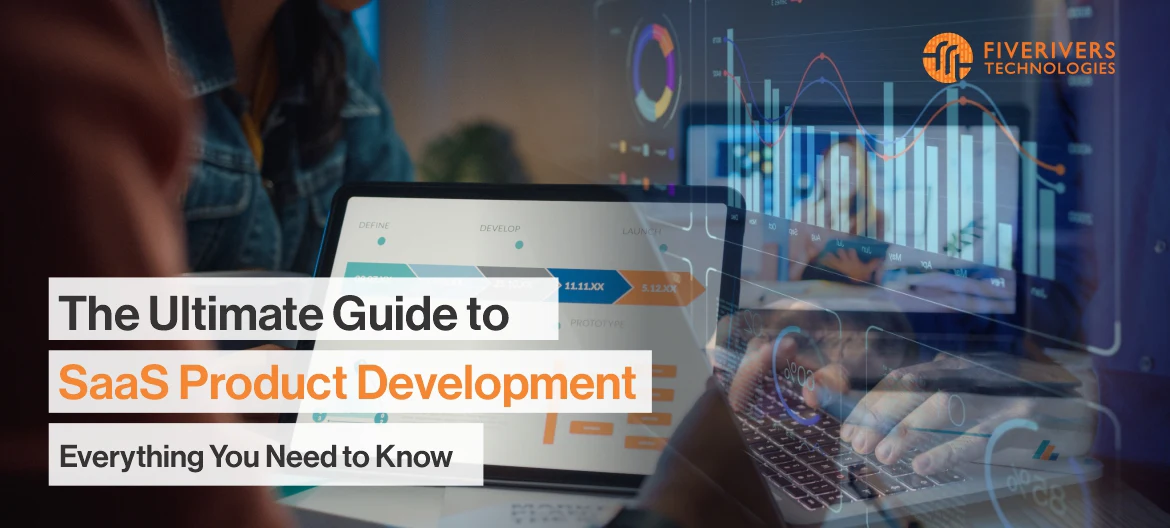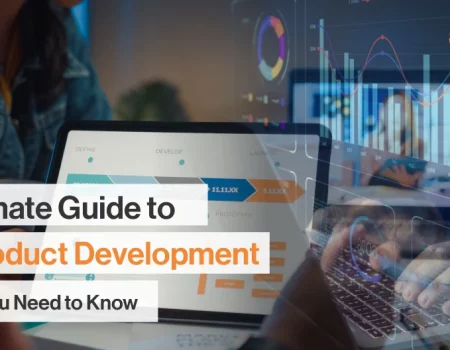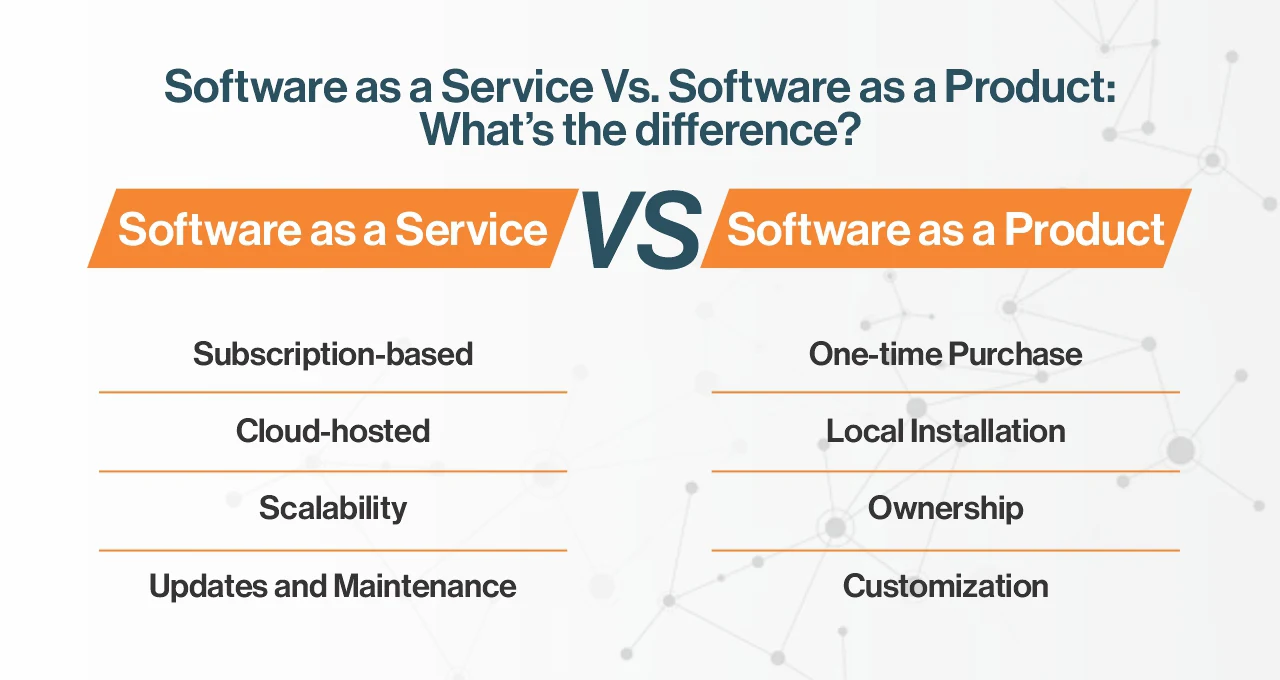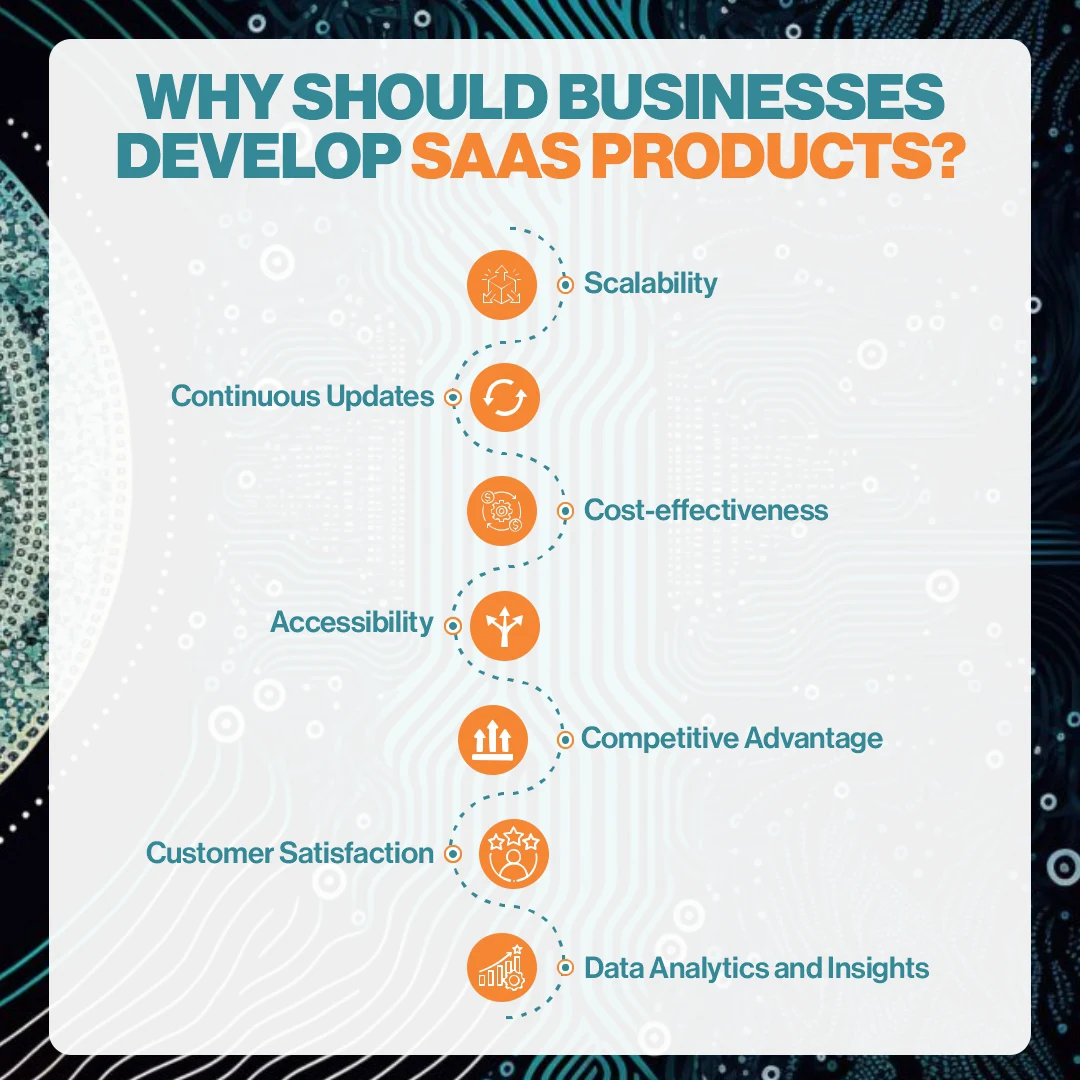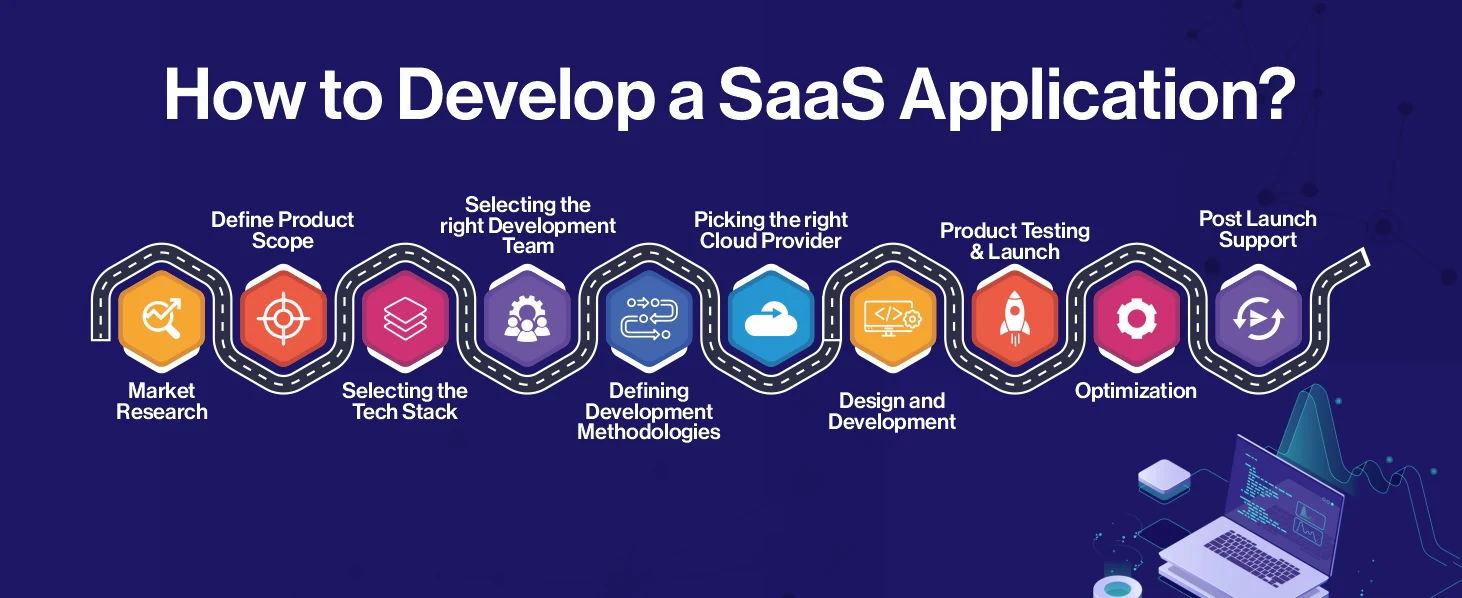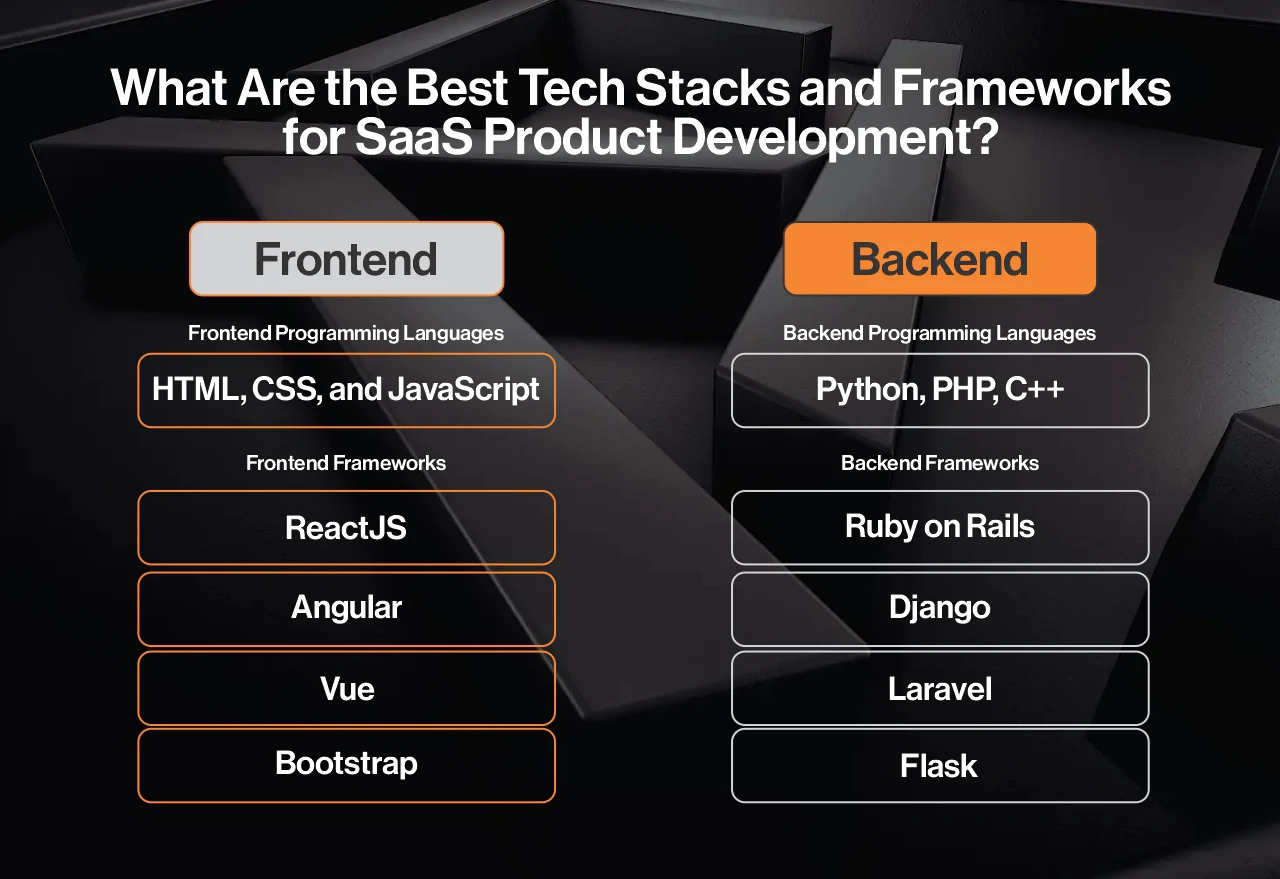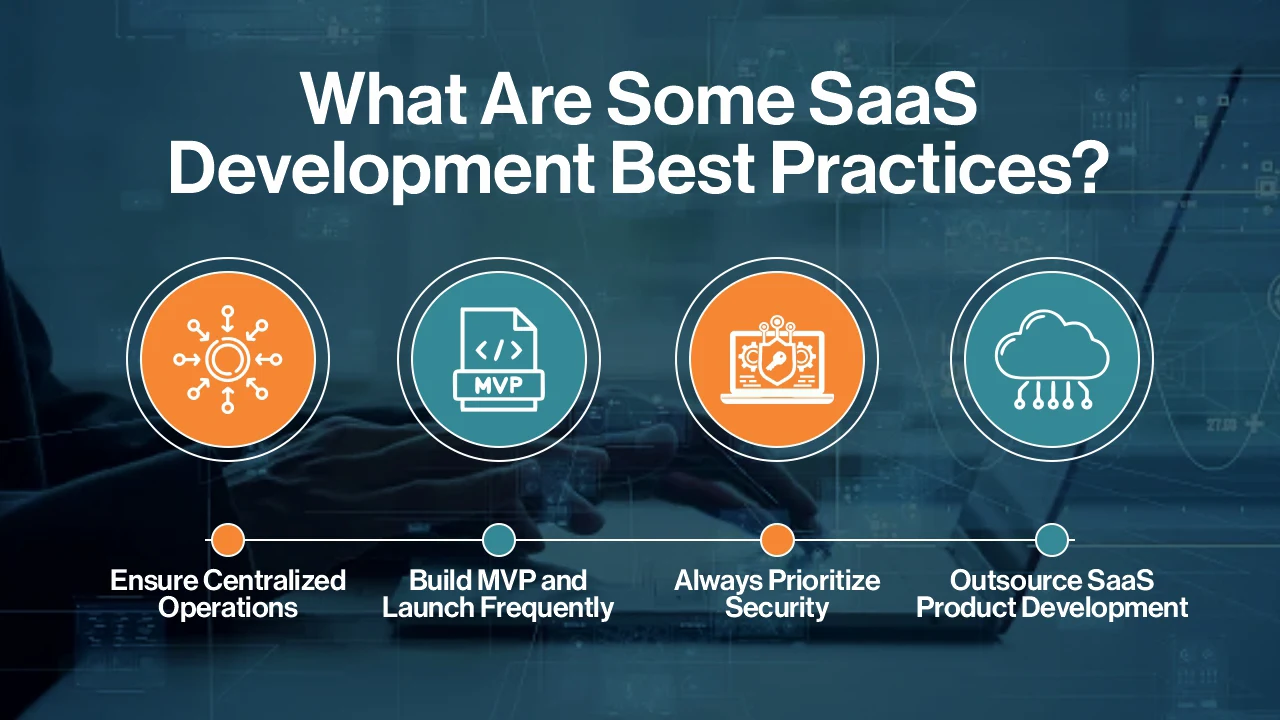The SaaS industry is booming like no other. In fact, the SaaS market size was estimated to be $237.48 billion in 2022, and, by 2030, it is estimated to reach $908.21 billion.
By looking at these numbers, we can see that SaaS products are the future and organizations can get a head start by investing in SaaS product development.
But SaaS product development isn’t as easy as it’s made out to be. In fact, 90% of SaaS startups fail to achieve the desired level of success and fail to generate revenue.
This is because startups, while focusing on core business needs, fail to recognize the level of expertise required to build a successful and sustainable SaaS product.
Moreover, startups underestimate the challenges that arise in SaaS product development and fail to recognize the opportunities they can benefit from.
But, in this guide, we will tell you what SaaS product development is, what are its benefits, what challenges you might have to face, what opportunities you can leverage, what are the steps to build a successful SaaS product, and why it’s important to hire a top team for SaaS product development.
Key Takeaways:
- SaaS products provide cost-effective solutions for various customer needs
- Software as a Service are cloud-based while Software as a Product are locally installed on a computer
- Organizations face third-party integrations, Issues of scalability, managing product lifecycles, and choosing a pricing model
- Organizations can harness the potential of AI/ML, cloud growth, and analytics
- Healthcare, eCommerce, and Content Management Systems are the industries with the highest SaaS potential
- Organizations need product owners, managers, developers, testers, scrum masters, UI/UX designers
What is a SaaS Product?
Software as a Service (SaaS) has revolutionized the way businesses access and utilize software applications. In essence, a SaaS product refers to software hosted on the cloud and provided to users over the internet on a subscription basis.
Unlike traditional software models where you purchase and install software on your computer or server, SaaS products are centrally hosted and maintained by the provider.
What is SaaS Product Development ?
SaaS product development refers to the process of creating and delivering software applications over the internet on a subscription basis. Unlike traditional software models where users purchase and install software on their computers or servers, SaaS products are hosted and maintained by the service provider, accessible to users via web browsers or APIs.
SaaS product development allows businesses to build a scalable SaaS application consisting of application servers, database layers, and a codebase. Hence, businesses don’t have to worry about how to maintain a SaaS application or manage the infrastructure, they just have to use the SaaS application.
If you get confused between the software you purchase and install on your PC with a SaaS product, then you might be wrong. There are a few differences between software as a service and software as a product.
Software as a Service (SaaS):
SaaS refers to software hosted on the cloud and accessed via the internet. Users typically subscribe to SaaS applications on a recurring basis, paying for the service they utilize. Its characteristics include:
Subscription-based: Users pay a recurring fee to access the software, usually on a monthly or yearly basis.
Cloud-hosted: The software is centrally hosted on cloud servers, eliminating the need for users to install and maintain it locally.
Scalability: SaaS applications can easily scale with the needs of the user, allowing for flexible usage and pricing models.
Updates and Maintenance: The provider is responsible for updates, maintenance, security, and infrastructure, relieving users of these burdens.
Software as a Product:
Software as a Product refers to traditional software that is sold as a one-time purchase, typically installed and operated on a user’s local hardware. Its characteristics include:
One-time Purchase: Users buy the software with a one-time payment, often accompanied by additional fees for updates and support.
Local Installation: The software is installed and run on the user’s local hardware, requiring maintenance, updates, and infrastructure management.
Ownership: Users have perpetual licenses for the software, granting them ownership and control over its usage.
Customization: Users may have more flexibility to customize and integrate the software with other systems according to their specific needs.
Why Should Businesses Develop SaaS Products?
Developing SaaS products offers numerous benefits to businesses, making it an attractive option in today’s competitive market landscape. Here’s why businesses should consider investing in SaaS platform development:
1. Scalability
SaaS products offer unmatched scalability, allowing businesses to effortlessly accommodate growth without worrying about infrastructure limitations, especially for startups.
With cloud-based architecture, resources can be scaled up or down dynamically based on demand, ensuring optimal performance even during peak usage periods.
2. Continuous Updates
Unlike traditional software models where updates are sporadic and often require manual intervention, SaaS products receive continuous updates and improvements.
This ensures that users always have access to the latest features, bug fixes, and security patches without the hassle of manual upgrades, enhancing the overall user experience.
3. Cost-effectiveness
SaaS eliminates the need for upfront investments in hardware, software licenses, and infrastructure, offering subscription-based pricing models that align with usage and scale.
This pay-as-you-go model allows businesses to minimize initial capital expenditures and only pay for the resources they use, making it a cost-effective option for both startups and established enterprises.
4. Accessibility
SaaS products can be accessed from any device with an internet connection, offering unparalleled accessibility and flexibility to users. Whether in the office, at home, or on the go, users can easily access SaaS applications via web browsers or mobile devices, increasing productivity and collaboration across teams.
5. Competitive Advantage
By embracing SaaS product development, enterprises can gain a competitive edge in the market by delivering innovative solutions faster and more efficiently than their competitors. The agility and scalability of SaaS enable companies to respond quickly to changing market dynamics, customer needs, and technological advancements, staying ahead of the curve.
6. Customer Satisfaction
SaaS products are designed with user-centricity in mind, focusing on delivering intuitive interfaces, seamless user experiences, and robust functionality.
Continuous updates and improvements based on user feedback ensure that customers are always satisfied with the product, leading to higher retention rates, positive reviews, and word-of-mouth referrals.
7. Data Analytics and Insights
SaaS products inherently generate vast amounts of data on user behavior, usage patterns, and performance metrics. Leveraging advanced analytics and machine learning algorithms, businesses can extract valuable insights from this data to drive informed decision-making, optimize product features, and personalize user experiences, ultimately driving business growth and profitability.
Opportunities in SaaS Product Development
SaaS product development presents a myriad of opportunities for businesses to innovate, grow, and differentiate themselves in the market. Here are some key opportunities in SaaS product development:
Harnessing the Potential of AI/ML
Integrating artificial intelligence (AI) and machine learning (ML) capabilities into SaaS products opens a world of possibilities for automation, personalization, and predictive analytics. From intelligent chatbots and recommendation engines to automated data analysis and anomaly detection, AI-powered SaaS products can revolutionize workflows, enhance decision-making, and drive efficiency across industries.
Expansion with Cloud Growth
The exponential growth of cloud computing presents vast opportunities for SaaS product developers to expand their offerings and reach new markets. Leveraging cloud infrastructure enables SaaS companies to scale their products globally, tap into emerging markets, and deliver high-performance, reliable solutions to a diverse range of customers without the constraints of physical infrastructure.
SaaS Products with Analytics at their Centre
Data is the lifeblood of modern businesses, and SaaS products that prioritize analytics and data-driven insights are poised for success. By integrating robust analytics capabilities at the core of their offerings, SaaS companies can empower users to derive actionable insights from their data, uncover hidden trends and patterns, and make informed decisions that drive business growth and innovation.
Improving Customer Experience
In today’s hyper-competitive market landscape, delivering exceptional customer experiences is paramount for SaaS success. Opportunities abound for SaaS product developers to enhance user interfaces, streamline workflows, and incorporate user feedback mechanisms to continuously improve the customer experience. By prioritizing usability, accessibility, and responsiveness, SaaS companies can foster customer loyalty, drive user adoption, and differentiate themselves from competitors.
Vertical SaaS
Vertical SaaS solutions cater to specific industries or niche markets, addressing unique pain points and requirements with tailored functionality and domain expertise. Opportunities abound for SaaS product developers to create specialized solutions for vertical markets such as healthcare, finance, real estate, and manufacturing, offering industry-specific features, compliance certifications, and integrations that deliver maximum value to customers.
Challenges in SaaS Product Development
SaaS product development presents unique challenges that require careful consideration and strategic planning. Here are some of the key challenges in SaaS product development:
Third-Party Integration
Integrating with third-party services and APIs is essential for enhancing the functionality and interoperability of SaaS products. However, managing multiple integrations can be complex, requiring thorough testing, documentation, and ongoing maintenance to ensure compatibility, reliability, and security.
Security & Data Protection
Security is a top concern in software development, as developers often handle sensitive customer data stored in the cloud. Ensuring robust security measures, such as encryption, access controls, and regular security audits, is crucial to protect against data breaches, cyberattacks, and compliance violations.
Issues of Scalability & Future Updates
SaaS products must be designed to scale seamlessly to accommodate growing user bases and increasing demands. This requires careful architectural planning, performance optimization, and capacity management to ensure that the infrastructure can support future growth without sacrificing reliability or performance. Additionally, managing frequent updates and new feature releases while minimizing disruption to users requires effective release management and communication strategies.
Managing Subscriber Lifecycles
Acquiring and retaining subscribers is critical for the success of SaaS products. From onboarding and activation to renewal and churn management, effectively managing the subscriber lifecycle requires personalized engagement, proactive support, and continuous value delivery to keep customers satisfied and loyal.
Choosing Pricing & Delivery Model
Selecting the right pricing and delivery model is crucial for SaaS success. Balancing affordability with profitability, understanding customer needs and willingness to pay, and staying competitive in the market are all key considerations when determining pricing tiers, subscription plans, and billing cycles. Additionally, choosing the appropriate delivery model, such as freemium, tiered pricing, or usage-based billing, can impact customer acquisition, retention, and revenue growth.
Maintaining Consistency
Consistency across different aspects of the SaaS product, including user experience, performance, and feature set, is essential for building trust and credibility with customers. However, as SaaS products evolve and scale over time, maintaining consistency can become challenging, especially when managing multiple platforms, devices, or user segments. Implementing robust quality assurance processes, adhering to design and development standards, and soliciting user feedback are crucial for ensuring consistency and reliability across the product ecosystem.
Industries With the Highest SaaS Potential
Several industries are experiencing significant growth and transformation due to the adoption of Software as a Service (SaaS) solutions. Here are some industries with high SaaS potential:
E-commerce
The e-commerce industry relies heavily on technology to manage online storefronts, inventory, payments, and customer relationships.
SaaS solutions offer e-commerce businesses the flexibility, scalability, and affordability they need to manage their operations efficiently, including platforms for e-commerce website development, order management, inventory management, customer relationship management (CRM), and marketing automation.
Healthcare
The healthcare industry is increasingly embracing SaaS solutions to streamline processes, improve patient care, and comply with regulatory requirements.
SaaS offerings in healthcare include electronic health record (EHR) systems, practice management software, telemedicine platforms, patient engagement tools, and health analytics solutions, enabling healthcare providers to deliver better outcomes while reducing costs and administrative burdens.
Content Management Systems (CMS)
Content management systems are essential for both startups and enterprises to create, manage, and publish digital content effectively.
SaaS-based CMS solutions offer businesses the flexibility to build and customize websites, blogs, and online stores without the need for extensive technical expertise or infrastructure investments. These platforms provide features such as content authoring, workflow management, collaboration tools, and digital asset management.
Communication
Communication is vital for businesses to collaborate effectively, whether internally among employees or externally with customers, partners, and suppliers.
SaaS communication solutions, such as email hosting, video conferencing, team messaging, and unified communications platforms, offer businesses the flexibility to communicate anytime, anywhere, across various devices and channels while reducing reliance on on-premises infrastructure and maintenance.
Project Management
Project management is essential for organizations to plan, execute, and track tasks and projects efficiently. B2B SaaS project management solutions provide teams with collaborative tools for task management, scheduling, resource allocation, budgeting, and reporting.
These platforms enable teams to work together seamlessly, regardless of location or time zone, and ensure projects are completed on time and within budget.
Government
Governments at various levels are increasingly adopting SaaS solutions to modernize their operations, improve service delivery, and enhance citizen engagement. SaaS offerings for government agencies include solutions for citizen relationship management, e-government portals, document management, public safety, and regulatory compliance. These solutions enable governments to streamline processes, increase transparency and deliver services more effectively to citizens.
How to Develop a SaaS Application?
A SaaS product development process involves a series of steps to conceptualize, design, develop, test, and launch a software-as-a-service product. Here’s a detailed breakdown of the process:
- Market Research
Before diving into any project, thorough market research is essential. It involves understanding the target audience, identifying competitors, analyzing market trends, and assessing potential demand. By conducting comprehensive market research, businesses can make informed decisions about product development, positioning, and marketing strategies. - Define Product Scope
Defining the product scope is crucial for setting clear boundaries and objectives for the project and creating a clear SaaS development roadmap. This involves outlining the features, functionalities, and requirements of the product. By clearly defining the product scope, stakeholders can avoid scope creeps, manage resources efficiently, and ensure that the final product meets user expectations. - Selecting the Tech Stack
Choosing the right technology stack is fundamental for building a scalable, secure, and efficient product. It involves selecting programming languages, frameworks, libraries, and tools that best suit the project requirements. Factors such as scalability, performance, security, and developer expertise should be considered when selecting the tech stack. - Selecting the Tech Stack
Choosing the right technology stack is fundamental for building a scalable, secure, and efficient product. It involves selecting programming languages, frameworks, libraries, and tools that best suit the project requirements. Factors such as scalability, performance, security, and developer expertise should be considered when selecting the tech stack. - Defining Development Methodologies
Choosing the appropriate development methodology is essential for organizing and managing the development process effectively. Popular methodologies include Agile, Scrum, Kanban, and Waterfall. Each methodology has its strengths and weaknesses, and the choice depends on factors such as project size, complexity, and team dynamics. - Picking the right Cloud Provider
Selecting the right cloud provider is crucial for ensuring scalability, reliability, and performance of the product. Factors such as cost, security, compliance, data residency, and service-level agreements (SLAs) should be considered when choosing a cloud provider. Popular options include Amazon Web Services (AWS), Microsoft Azure, Google Cloud Platform (GCP), and IBM Cloud. - Pricing & Delivery Model
Determining the pricing and delivery model is essential for monetizing the product and delivering value to customers. Pricing models can vary from one-time purchases to subscriptions, freemium, or pay-per-use models. Similarly, the delivery model can range from traditional on-premises deployment to cloud-based SaaS (Software as a Service) or PaaS (Platform as a Service) offerings. The choice depends on factors such as market demand, competitive landscape, and business objectives. - Design and Development
Design and development are critical stages in bringing a product to life, ensuring it meets the needs and expectations of its users. Here’s a breakdown of the key components involved in this process:- Design User Flow & Wireframing
At the outset, the process entails meticulous planning and visualization, starting with designing user flows and wireframing. This stage involves mapping out the path’s users will take within the product and creating skeletal outlines or wireframes of key screens or interfaces. By delineating user journeys and interface layouts early on, teams can ensure a clear understanding of how the product will function and how users will interact with it. - MVP Development
Once the initial design framework is in place, the focus shifts to developing a Minimum Viable Product (MVP). This involves identifying and prioritizing the core features and functionalities that will provide the most value to users. Rapid prototyping is often employed to swiftly build and test basic versions of the product, allowing for iterative refinement based on user feedback. Through this iterative development process, teams can incrementally enhance the MVP, ensuring that subsequent iterations align closely with user needs and market demands. - UI/UX Designing
UI/UX designing plays a crucial role in shaping the visual and experiential aspects of the product. User Interface designers focus on creating visually appealing and intuitive interfaces that reflect the brand identity while facilitating seamless navigation. User Experience designers, on the other hand, concentrate on optimizing the overall user journey, ensuring that interactions with the product are intuitive, enjoyable, and efficient. Prototyping and mockups are commonly utilized to visualize the final product and solicit feedback from stakeholders, facilitating further - SaaS Product Development
For products delivered as SaaS, specialized considerations come into play during development. This includes designing scalable cloud architectures to accommodate varying levels of user demand and implementing robust subscription management systems for billing and user authentication. Additionally, features such as multi-tenancy support are essential for SaaS products, enabling secure and efficient sharing of resources among multiple users or tenants.
- Design User Flow & Wireframing
How to Launch a SaaS Product?
Product Testing & Launch
As the development progresses, thorough testing and validation are imperative to ensure product quality and reliability. Quality assurance measures involve comprehensive testing across different devices, browsers, and operating systems to identify and rectify any bugs or issues.
Beta testing may also be conducted, allowing a select group of users to provide real-world feedback before the product is officially launched. Deployment planning is crucial to ensure a smooth transition from development to production environments, minimizing disruption and ensuring a seamless user experience.
Optimization
Following the product launch, the focus shifts towards optimization and continuous improvement. Performance optimization efforts aim to enhance speed, efficiency, and resource utilization, thereby improving the overall user experience. Conversion rate optimization (CRO) strategies are employed to analyze user behavior and optimize conversion paths, ultimately increasing user engagement and retention.
Continuous improvement processes, including monitoring of product metrics and prioritization of feature enhancements, ensure that the product remains relevant and competitive in a dynamic market landscape.
By incorporating these elements into the design and development process, teams can create products that resonate with users, drive business growth, and adapt to evolving market needs.
Post Launch Support
Post-launch support is a crucial aspect of product development that ensures the smooth operation and ongoing success of a product after it has been released to the market. It involves providing assistance, maintenance, and updates to users to address any issues, implement enhancements, and optimize performance.
What Should the SaaS Development Team Structure be?
Creating a successful Software as a Service (SaaS) product requires a well-rounded team with diverse skills and expertise. Each role plays a crucial part in the development process, contributing to the overall success of the product.
Product Owner
The product owner is responsible for defining and prioritizing the product backlog, ensuring that the development team is working on the most valuable features that align with the business goals and user needs. They act as the bridge between the development team and stakeholders, providing vision and direction for the product.
Product Manager
Working closely with the product owner, the product manager oversees the entire SaaS product lifecycle, from ideation to launch and beyond. They conduct market research, gather user feedback, and define the product roadmap. Product managers collaborate with cross-functional teams to ensure that the product meets customer requirements and drives business growth.
Scrum Master
In an agile development environment, the scrum master facilitates the scrum process, helping the team adhere to agile principles and practices. They remove impediments, foster collaboration, and ensure that the team remains focused on delivering high-quality increments of work during each sprint.
Business Analyst
Business analysts play a critical role in translating business needs into actionable requirements for the development team. They gather and analyze user requirements, conduct stakeholder interviews, and create user stories or specifications. Business analysts ensure that the product meets both functional and non-functional requirements while addressing user pain points.
UI/UX Designers
User interface (UI) and user experience (UX) designers focus on creating intuitive and visually appealing interfaces that enhance the overall user experience.
They conduct user research, create wireframes and prototypes, and collaborate with stakeholders to design user-centric solutions. UI/UX designers work closely with front-end developers to implement their designs effectively.
Backend Developers
Backend developers are responsible for building the server-side logic, databases, and APIs that power the SaaS application.
They write clean, efficient code using languages and frameworks suited for backend development, ensuring scalability, security, and performance. Backend developers collaborate with frontend developers to integrate frontend and backend components seamlessly.
Frontend Developers
Frontend developers specialize in building the client-side components of the SaaS application, including user interfaces and interactions. They implement designs provided by UI/UX designers, write front-end code using HTML, CSS, and JavaScript, and optimize the application for responsiveness and performance across various devices and browsers.
Quality Assurance Engineers
QA engineers are responsible for ensuring the quality and reliability of the SaaS product through comprehensive testing. They develop test plans, execute manual and automated tests, and identify bugs or issues throughout the development lifecycle. QA engineers work closely with developers to address defects promptly and maintain the overall product quality.
What Are the Best Tech Stacks and Frameworks for SaaS Product Development?
When embarking on the journey of SaaS (Software as a Service) product development, selecting the right tech stack and frameworks is crucial for ensuring scalability, performance, and maintainability. Let’s explore some of the best options for both frontend and backend development:
Frontend
Frontend Programming Languages
HTML, CSS, and JavaScript
These foundational technologies are essential for building the structure, style, and interactivity of web applications. HTML provides the structure, CSS offers styling capabilities, and JavaScript enables dynamic behavior and interaction.
Frontend Frameworks
ReactJS
Developed by Facebook, ReactJS is widely adopted for its component-based architecture, virtual DOM, and efficient rendering.
It’s known for its flexibility and performance, making it suitable for building complex user interfaces.
Angular
Maintained by Google, Angular is a comprehensive framework that offers features like two-way data binding, dependency injection, and modular development.
It provides a robust solution for building large-scale applications with MVC architecture.
Vue
Vue is a progressive JavaScript framework that is lightweight and easy to integrate into existing projects.
It emphasizes simplicity and flexibility, making it a popular choice for startups and small to medium-sized projects.
Bootstrap
Bootstrap is a CSS framework that offers pre-designed templates and components for building responsive and visually appealing web interfaces. It simplifies frontend development by providing a grid system, typography, forms, and other UI components.
Backend
Backend Frameworks
Ruby on Rails
Ruby on Rails is a full-stack web framework known for its convention over configuration principle and rapid development capabilities.
It follows the MVC pattern and includes features like ORM (Active Record), routing, and scaffolding, which streamline development.
Django
Django is a high-level Python web framework that promotes rapid development, clean design, and pragmatic principles. It comes with built-in features like an admin panel, ORM (Django ORM), authentication, and routing, enabling developers to focus on building applications.
Laravel
Laravel is a PHP framework that offers expressive syntax, modular packaging system, and robust features like ORM (Eloquent), routing, middleware, and authentication. It’s known for its elegant syntax and developer-friendly ecosystem.
Flask
Flask is a lightweight and flexible Python framework suitable for building small to medium-sized web applications. It provides essential features for web development while allowing developers the freedom to choose components and extensions based on project requirements.
Backend Programming Languages
Python
Python is a versatile programming language known for its simplicity, readability, and extensive standard library. It’s widely used in backend development due to frameworks like Django and Flask, as well as its suitability for data processing, machine learning, and automation tasks.
PHP
PHP is a server-side scripting language specifically designed for web development. It powers frameworks like Laravel and Symfony, making it a popular choice for building dynamic and interactive web applications.
C++
While less commonly used for web development compared to Python and PHP, C++ is a powerful programming language known for its high performance and efficiency. It’s often utilized in backend systems requiring low-level optimizations, such as gaming servers or high-frequency trading platforms.
Factors Affecting SaaS Development Cost
When estimating the cost of SaaS development, various factors come into play, each influencing the overall expenditure. Here’s a breakdown of the key factors affecting SaaS development cost:
1. Product Size
The scale and scope of the SaaS product significantly impacts development costs. Larger products with extensive features, multiple modules, and scalability requirements generally require more development effort and resources, leading to higher costs.
2. Team Size
The size and composition of the development team directly affect development costs. Larger teams may incur higher expenses in terms of salaries, overhead, and management. Additionally, hiring specialized talent or outsourcing certain tasks can impact costs.
3. Product Complexity
The complexity of the SaaS product, including its functionality, user experience, integration capabilities, and business logic, influences development costs. More complex products often involve intricate development tasks, testing procedures, and maintenance efforts, leading to increased costs.
4. Application Features
The number and complexity of features required in the SaaS application significantly impacts development costs. Features such as user authentication, data management, analytics, third-party integrations, and real-time communication may incur additional development expenses.
5. Technological Architecture
The choice of technological stack, frameworks, libraries, and infrastructure solutions affects development costs. Utilizing cutting-edge technologies or proprietary systems may involve higher licensing fees, development time, and maintenance costs compared to using open-source or widely adopted technologies.
6. Integration Requirements
Integration with external systems, APIs, databases, or services adds complexity to SaaS development and may incur additional costs. Factors such as the number of integrations, compatibility issues, data synchronization, and security considerations impact the overall development budget.
7. Choice of Development Model
The selected development model, such as Agile, Waterfall, or DevOps, influences SaaS development costs. Agile methodologies, characterized by iterative development and frequent feedback cycles, may result in more adaptable and cost-effective development but can also require continuous resource allocation.
What are Some SaaS Development Best Practices?
Developing a successful SaaS product requires adherence to best practices that prioritize efficiency, innovation, and customer satisfaction. Here are some key best practices for SaaS product development:
1. Ensure Centralized Operations
Establishing centralized operations ensures seamless collaboration, efficient communication, and streamlined workflows among development teams, stakeholders, and departments. By centralizing operations, you can enhance productivity, reduce duplication of efforts, and maintain consistency across the development process.
2. Build MVP and Launch Frequently
Adopting an iterative approach by building a Minimum Viable Product (MVP) allows you to validate product assumptions, gather user feedback, and iterate based on real-world usage. Launching MVPs frequently enables you to deliver value to customers faster, test new features, and adapt to market demands efficiently. This approach fosters continuous improvement and helps in prioritizing features that resonate with users.
3. Always Prioritize Security
Security should be a top priority throughout the SaaS product development lifecycle. Implement robust security measures, such as data encryption, authentication mechanisms, access controls, and regular security audits, to safeguard sensitive data and protect against cyber threats. Compliance with industry standards and regulations (e.g., GDPR, HIPAA) is essential to maintaining trust and compliance with legal requirements.
4. Outsource SaaS Product Development
Outsourcing certain aspects of SaaS product development, such as specialized development tasks, design work, or quality assurance, can offer various benefits. Outsourcing allows you to access a broader talent pool, leverage expertise in specific technologies or domains, accelerate development timelines, and reduce costs. However, it’s crucial to choose reliable outsourcing partners and establish clear communication channels to ensure alignment with your project goals and standards.
How to Choose the Right SaaS Product Development Company?
1. Read Reviews
Start by researching and reading reviews of SaaS development companies online. Platforms like Clutch, Capterra and G2 Crowd provide valuable insights into the reputation, expertise, and client satisfaction of various companies.
2. Shortlist Companies
Based on your research, create a shortlist of SaaS development companies that align with your project requirements, budget, and preferences. Consider factors such as industry experience, technology expertise, and portfolio quality.
3. Share Project Requirements
Reach out to the shortlisted companies and share your project requirements, objectives, timeline, and budget constraints. Clear communication at this stage ensures that both parties have a mutual understanding of the project scope and expectations.
4. Discuss Engagement Models
Discuss various engagement models, such as fixed-price, time and materials, or dedicated team, with the SaaS development companies. Choose the engagement model that best suits your project needs, risk tolerance, and budgetary constraints.
5. Get Quotes
Request detailed project proposals and quotes from the SaaS development companies. Ensure that the quotes include all relevant costs, such as development fees, maintenance charges, and additional expenses.
6. Setup Interviews and Evaluate Experience & Skills
Schedule interviews or meetings with the key stakeholders and development teams of the shortlisted companies. During the interviews, evaluate their experience, technical skills, communication abilities, and cultural fit. Ask relevant questions about their previous projects, methodologies, and problem-solving approaches.
7. Check References
Ask for references from past clients or projects like yours. Contact these references to gain insights into their experiences working with the SaaS development company, including project management, communication, quality of deliverables, and overall satisfaction.
8. Evaluate Cultural Fit
Consider the cultural fit between your organization and the SaaS development company. Look for shared values, work ethic, and communication styles that promote collaboration and synergy.
9. Review Contracts and Legal Agreements
Before finalizing your decision, review and negotiate contracts and legal agreements with the chosen SaaS development company. Ensure that all terms, conditions, and deliverables are clearly defined to avoid misunderstandings or disputes later.
10. Onboard the Team
Once you’ve selected the right SaaS development company, onboard their team and establish clear communication channels, project milestones, and expectations. Foster a collaborative environment and maintain regular updates and feedback loops throughout the development process.
Why Choose FiveRivers Technologies for SaaS Product Development?
1. Over 20 Years of Experience
With more than two decades of experience in the software industry, FiveRivers Technologies is the best SaaS application development company that brings a wealth of knowledge, expertise, and insights to the table. This extensive experience demonstrates their ability to navigate various challenges, adapt to evolving technologies, and deliver high-quality solutions that meet clients’ needs.
2. Over 200+ Software Professionals
As a top IT outsourcing company, FiveRivers Technologies boasts a team of over 200 software professionals with diverse skill sets, including developers, designers, engineers, and project managers.
This robust talent pool enables us to assemble dedicated teams tailored to specific project requirements, ensuring comprehensive expertise and resource availability throughout the development process.
3. Successfully Delivered 500+ Custom Solutions
As a top SaaS software development company, we have successfully delivered over 500 custom solutions. FiveRivers Technologies has a proven track record of client satisfaction and project success. This impressive portfolio demonstrates our ability to understand client objectives, address unique challenges, and deliver tailored solutions that drive business value and innovation.
4. Client-Centric Approach
FiveRivers Technologies prioritizes client satisfaction and collaboration, striving to understand clients’ goals, requirements, and expectations thoroughly.
We emphasize transparent communication, proactive problem-solving, and a client-centric approach to ensure alignment and successful project outcomes.
5. Adherence to Quality Standards
With a commitment to excellence, FiveRivers Technologies adheres to industry best practices, quality standards, and rigorous testing procedures to deliver robust, scalable, and reliable SaaS products. We focus on quality assurance ensuring that delivered solutions meet the highest standards of performance, security, and usability.
FAQs
What is SaaS-based product development?
SaaS-based product development refers to creating software products that are delivered and accessed over the cloud as a service. This model allows users to access the software through a web browser without needing to install or maintain it locally.
What is the SaaS Lifecycle?
A SaaS lifecycle refers to the stages that a SaaS product typically goes through from its inception to its retirement. These stages include:
- Conception
- Development
- Launch
- Growth
- Maturity
- Decline
- Retirement
How to Make a SaaS Product Roadmap?
A SaaS product roadmap involves strategic planning and alignment of various components such as product vision, customer needs, market trends, and business objectives.
- Define Your Vision and Goals
- Understand Your Customers
- Prioritize Features
- Create a Timeline
- Communicate and Collaborate
- Monitor Progress and KPIs
- Review
- Launch
- Incorporate User Feedback
- Rollout Continuous Updates



